

Compelling facts about email (ab)use in organizations. It has almost become a truism that the average corporate employee spends around 25-30 percent of the workday on email related tasks.
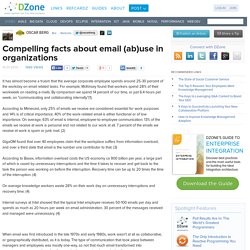
For example, McKinsey found that workers spend 28% of their workweek on reading e-mails. By comparison we spend 14 percent of our time, or just 6.4 hours per week, on "communicating and collaborating internally. "(1). According to Mimecast, only 25% of emails we receive are considered essential for work purposes and 14% is of critical importance. 40% of the work-related email is either functional or of low importance. GigaOM found that over 40 employees claim that the workplace suffers from information overload, and over a third state that email is the number one contributor to that. (3) According to Basex, information overload costs the US economy ca 900 billion per year, a large part of which is cased by unnecessary interruptions and the time it takes to recover and get back to the task the person was working on before the interruption.
Sources: The Death of Email by 2018. In September 2008 I predicted the death of email as we know it within 10 years, to be replaced by something more collaborative in the social world we now find ourselves living in.
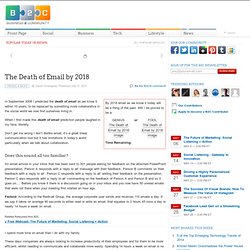
When I first made this death of email prediction people laughed in my face, literally. Don’t get me wrong I don’t dislike email, it’s a great linear communication tool but it has limitations in today’s world particularly when we talk about collaboration. Does this sound all too familiar? An email arrives in your inbox that has been sent to 30+ people asking for feedback on the attached PowerPoint presentation. Person A responds with a ‘reply to all’ message with their feedback. Factoid: According to the Radicati Group, the average corporate user sends and receives 110 emails a day. I spend more time on email than I do with my family. These days companies are always looking to increase productivity of their employees and for them to be more efficient, whilst needing to communicate and collaborate more easily.
Only One In Three Emails Received Is ‘Essential’ For Work. News Millions of websites, applications from Cisco and VMware, Google Play apps, as well as millions of Android devices are vulnerable -- and the list keeps growing.By Mathew J.
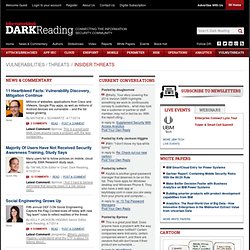
Schwartz , 4/17/2014 2 comments | Read | Post a Comment Quick Hits Many users fail to follow policies on mobile, cloud security, EMA Research study says.By Tim Wilson Editor in Chief, Dark Reading, 4/10/2014 12 comments | Read | Post a Comment Fifth annual DEF CON Social Engineering Capture the Flag Contest kicks off today with new "tag team" rules to reflect realities of the threat.By Kelly Jackson Higgins Senior Editor, Dark Reading, 4/7/2014. New Research Reveals Banning Email in the Workplace Wrong Approach to Email Overload. Distractions at Work: E-mail Tops the List. E-mailing is the most distracting online activity in the workplace, according to a recent BLR poll.
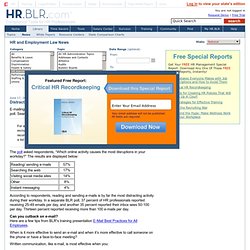
Searching the web and visiting social media sites were the next two contenders. For a Limited Time receive a FREE HR Report "Critical HR Recordkeeping. " This exclusive special report covers hiring records, employment relationships, termination records, litigation issues, electronic information issues, tips for better recordkeeping, and a list of legal requirements. Download Now The poll asked respondents, “Which online activity causes the most disruptions in your workday?”
According to respondents, reading and sending e-mails is by far the most distracting activity during their workday. Is Email Overload Killing Your Productivity? Workers spend 61 per cent of their day lost in email and information. We spent 61 per cent of our office time deadling with emails, retrieving information and collaborating; and only 39 per cent actually performing tasks.

The average office worker spends 28 hours a week – or nearly 1500 hours a year - writing emails, searching for information and attempting to "collaborate" internally, according to a new report. No wonder, they feel their working hours slipping by as the time left to do "real work" stretches beyond the traditional 9 to 5. A new global report by McKinsey Global Institute, the research arm of management consultancy McKinsey & Company, argues wide adoption of social media technologies by businesses could cut down some of the time-wasting involved in emailing and improve worker productivity by 20 to 25 per cent. Advertisement Social media technologies include software products and services that allow people to connect more efficiently than via email.
Is work overload worse than smoking pot? Email’s Dark Side: 10 Psychology Studies. Email is a fantastic tool, but these ten psychology studies remind us of its dark side.
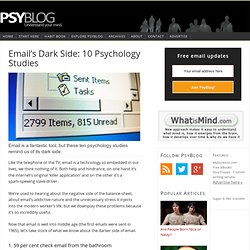
Like the telephone or the TV, email is a technology so embedded in our lives, we think nothing of it. Both help and hindrance, on one hand it’s the internet’s original ‘killer application’ and on the other it’s a spam-spewing slave-driver. We’re used to hearing about the negative side of the balance-sheet, about email’s addictive nature and the unnecessary stress it injects into the modern worker’s life, but we downplay these problems because it’s so incredibly useful. 1 in 5 UK workers spend 32 days a year managing email.